Having returned from a short holiday in Scotland almost a week before, I was relieved to see that the Northern waterthrush had stayed at Heybridge, Maldon in Essex. It had been a very popular bird, primarily due to it being the eighth recorded in Britain - seven previous records between 1958 and 2019. This is a first for Essex, only the third mainland record, and the first British record since 2011.
It breeds in the northern part of North America, in Canada, and the northern United States. It is migratory, wintering in Central America, the West Indies and Florida. It is a very rare vagrant to other South American countries or to western Europe. It likes "swampy or wet woods" as habitats but is more commonly seen in tropical climates during the winter and actually resembles a large pipit rather than a "thrush" - maybe a dwarf redwing … without the red. Typically it feeds on insects and other small invertebrates on streams or pond edges.
Kev @kev07713 and I knew that visiting on a Saturday we'd encounter more people but there had been opportunities the previous weekend and over the sunsequent five weekdays - we left early to ensure that even after a stop for breakfast we'd be there by 7.00am, with sunrise scheduled for 07.59am. Kev had visited more than a week before while I was away but understood this was a bird I'd like to see - hopefully we'd be able to make later plans based on what else was reported in the area that morning.
We arrived to find hordes of people already in place - around 200 at a quick estimate, with more trying to view from the other end of the creek - mayhem. We joined on the lefthand edge only to discover that you couldn't see the creek at all from here and so pushed through and knelt in the mud in front of the line of scopes, and behind people sitting on the grass. I put down my gloves to try and limit the damage to my trousers - this turned out to be a futile exercise and simply resulted in more items to wash when I returned home. At least we had a view from here.
At 07.26am the crowd's attention was raised when the bird was spotted halfway down the creek - it took me a while to latch on but then I had my second life tick of the year. I used my camera to follow the bird as it was much brighter than the current conditions - I tried to take a few photos but my settings meant that the shutter speed was too slow. The bird fed up and down the channel eventually venturing right up to the sluice - the closest position it could be to us. Now I encountered a new issue - I had the camera set for crop instead of full frame and it was increasingly difficult to follow the bird as it walked, hopped and flew across the water and from perch to perch. I switched out and managed to fire off a few shots before the bird flew back along the creek and out of range. Shortly after it flew right out of the creek and into the reeds beyond. It was now 08.15am and we'd had good views so decided to move out to give those that had been less fortunate than ourselves a chance to view - a dozen or more people around us did the same.
As we left, we bumped into Penny @FegWitch and Ann, stopping briefly for a chat with them and two of their friends. They were going to Abberton Reservoir with hope of the canvasback (not been reported for a couple of days), the smews and a possible Slavonian grebe. We now looked on our phones and opted instead for a trip over to Bradwell-on-Sea to try for the red-breasted goose (another species I hadn't seen in 2023). We said our goodbyes and made the journey of just over half an hour.
We arrived, and Kev said that he'd been told that the bird was likely to be a 2-mile walk out to where the main brent geese flock were feeding. Our target was a first-winter bird but worth the visit. The red-breasted goose is native to Eurasia and is a relative of the brent goose, despite its appearance. It is threatened by habitat loss and has been in decline over the last few decades to the point it is classed as endangered. They breed in Arctic Siberia and usually spend their winters along the shores of the Black, Caspian, and Arial seas. They are typically found on riverbanks, flooded fields, wooded tundra, lakes, and marshes.
We set off down the track and saw a couple of birders down on the edge of the Saltmarsh - we'd likely be following them along - to our left was a flock of brent geese but it didn't contain our bird. With them were a handful of lapwings. When we got closer to the church (the Chapel of St Peter-on-the-Wall), we met the birders coming back up the track - apparently the walk had put them off and they were going to give it a miss (they'd heard it was 3½ miles to the bird while my maps suggested 2½) - Kev said he hoped it would be the latter. Looking out over the bay from the church we could see more brent geese, knot, dunlin, curlews and more. Kev piped up and said there was a short-eared owl perched on a post and when I got my bins on it, it was a gnome - oh he thinks he is very funny.
Walking along the path Kev called a harrier and as it was flying away from us, we couldn't be absolutely sure of the species - with the grey it may have been a male hen harrier - we will never know. We joined up with a few other birders that had been catching us up - one had just seen a male hen harrier ... we added views of both male and female marsh harriers. After around 1½ miles we came to a bend in the path and out in front of us was the main brent flock, feeding and swaying back and forth from left to right. It was quite difficult to pick out the red-breasted goose from the others, but easier on the scope. I considered taking a photo but away from the scope I always lost the bird. After a few minutes our bird made it to the front and I had much better views on the scope - this was my chance - I got a line and raised my camera as the flock took off, whirled around a couple of times, and landed a couple of fields away. Fortunately, Kev got some video and below is a screen grab from one of those.
There was a cold breeze and we realised we'd need to move on to stay warm. We started back and a couple of birders strode out, leaving us behind while we followed another and out into the Saltmarsh - much closer to the shore. Once at the closest point we could pick out many more of the species on the water and shore: dunlin, knot, bar-tailed godwits, oystercatchers, grey plovers, pintails, red-breasted mergansers, turnstones, and more. Quite a few year ticks amongst us.
Our companion said goodbye and made his way along the track at a fair pace while we took it steadier. We were watching the passing waders when a ringtail/female hen harrier came into view along the edge of the Saltmarsh and where it meets the shore. We watched it quarter the area but purposefully making progress from our left to right. We had excellent views and were warmed by the experience - the cold couldn't touch us now.
We joked that we would find a merlin on one of the posts dotted across the marsh but never did, although we had more views of marsh harriers. Eventually we made it back onto the main path and started back towards the church.
In the distance flocks of waders sparkled in the sky, as they often do in sunlight and when numbers are in the thousands. Movement at the edge of my field of view caught my attention and as I scanned there was a merlin acrobatically attempting to capture a small bird. Thankfully I managed to get Kev on it to see the action - wow, that was special. All distant but a feast for the eyes through our bins. We continued on and spotted the merlin perched in various bushes and scrub - at one point it took to the wing, flew along the shore and then up high, only to be lost right. With distance and the sun, it was hard to get any sort of record shot.
We continued and noted the flocks of knot and dunlin on the shore - part of the flock that we'd seen earlier no doubt. In the field to our right, we saw a dozen or so golden plover, and a pair of stonechats.
We stopped and visited the church to find out about its history. The Chapel is open during the day to visitors and in the summer, they hold a 09.00am Communion service on the last Thursday in the month and every Thursday during July and August. During the winter months services are less regular - the website provides details.
In AD 653 St. Cedd had sailed down the east coast of England from Lindisfarne and landed at Bradwell, finding the ruins of an old deserted Roman fort. The Chapel is said to be that of "Ythanceaster" (Bede, Historia Ecclesiastica), originally constructed as an Anglo-Celtic Church for the East Saxons in AD 654, astride the ruins of the abandoned Roman fort of Othona.
In June 1916 the Parker family who owned the chapel gave it to Chelmsford Cathedral. In 1920 it was restored and re-consecrated. Soon after this the annual pilgrimage started at the beginning of July each year. The day-to-day maintenance and care for the chapel has always been carried out by the parish church, whose Rector was Chaplain until 2010. In 1959 it gained the Grade I listed status.
The first altar was made from oak beams from Chelmsford Cathedral that was being restored at this time. This was replaced in the 1980s when a new stone altar was installed with stones from Iona, Lindisfarne and Lastingham.
On the track back up to the car we were stopped watching lapwings in the field, with pied wagtails over, when we heard a strange call - corn buntings. It took only seconds to locate two sitting atop some trees back down the path - one continued to call but all too soon they were gone. Kev insisted that I should have jumped on the scope for a better look - I had photos ...

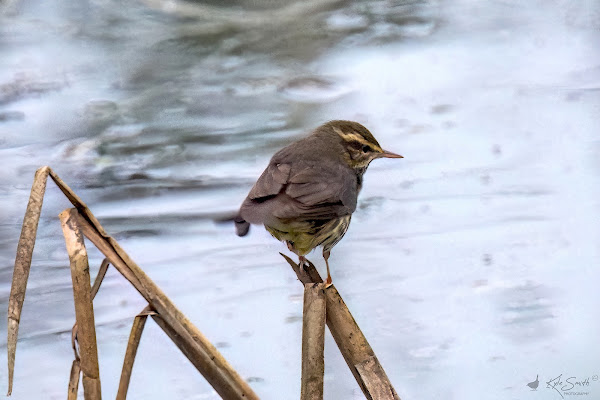
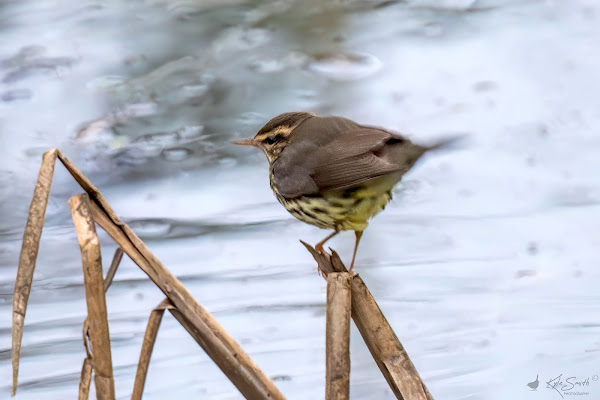

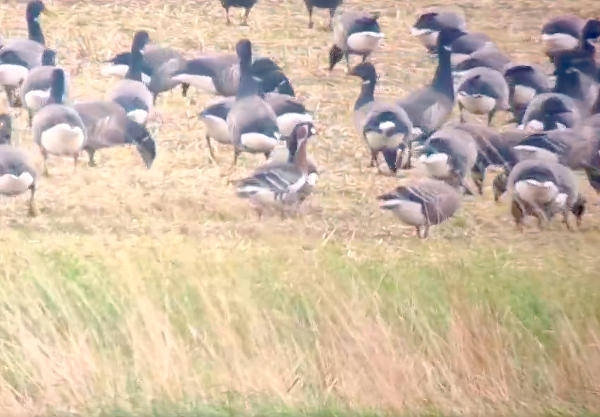
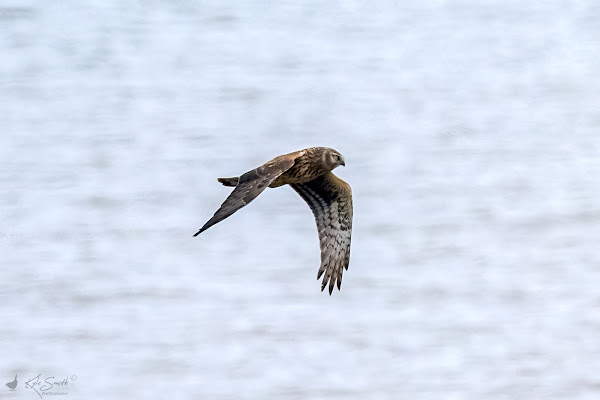
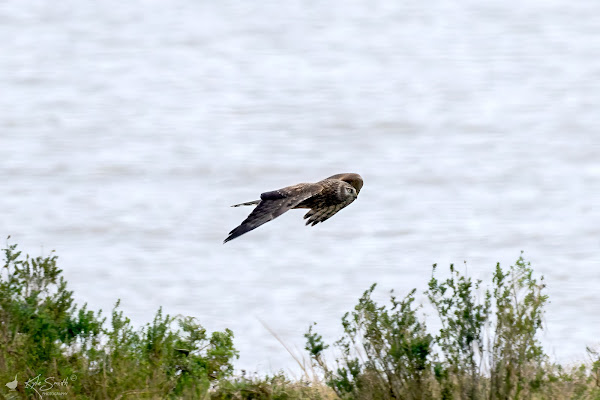


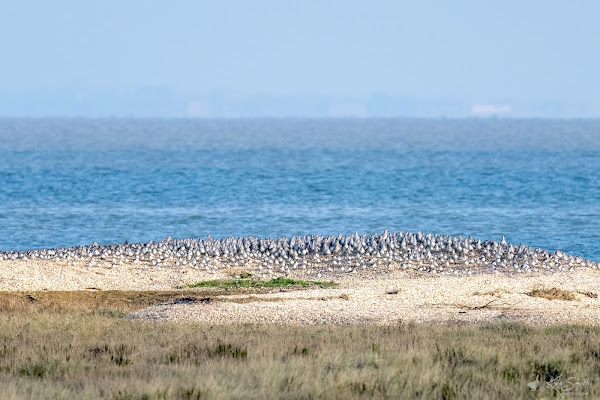
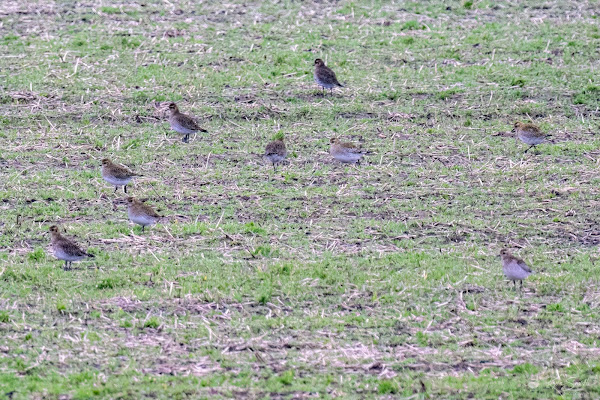


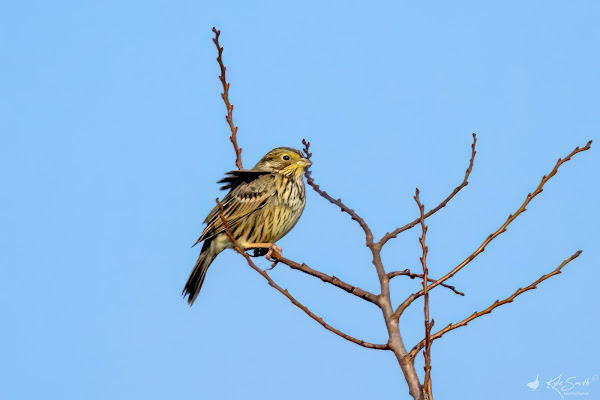
No comments:
Post a Comment